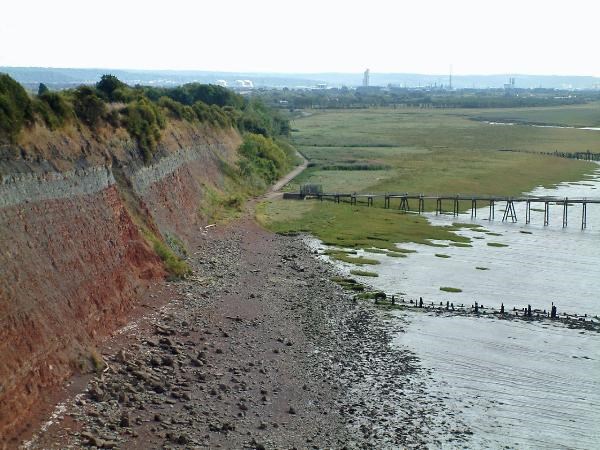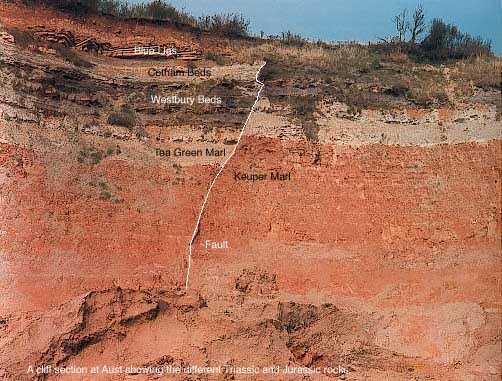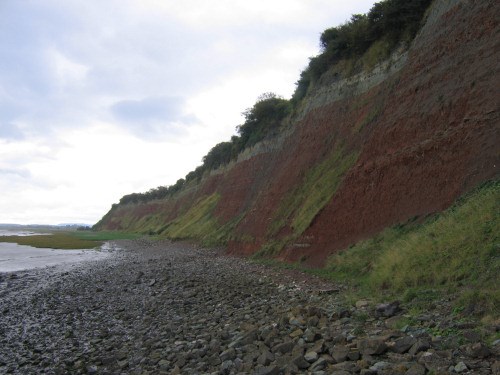Aust Cliff EarthCache
-
Difficulty:
-

-
Terrain:
-

Size:  (other)
(other)
Please note Use of geocaching.com services is subject to the terms and conditions
in our disclaimer.
In memory of keehotee who owned the original Alabaster Cliffs earthcache here.
Aust Cliff (grid reference ST565894) is a 5.3 hectare geological Site of Special Scientific Interest adjacent to the Severn Estuary, near the village of Aust, South Gloucestershire, notified in 1954.
The Severn Bridge crosses the cliff.
Its SSSI designation is due to the presence of fossil beds.

The Famous Red and White cliffs that can be seen when crossing the river Severn contain a highly productive bone bearing bed at the very top from the Rhaetian Penarth series. This bed is full of teeth, reptile, fish and dinosaur remains.

The uppermost beds at the top of Aust Cliff are marine deposits from the Lower Lias.
Just below this level, too dangerous to reach from above and too high to reach from the ground is the Westbury Formation from the Rhaetic beds.
The Rhaetian is in geochronology the latest age of the Triassic period or in chronostratigraphy the uppermost stage of the Triassic system. It lasted from ~208.5 to 201.3 ± 0.2 million years ago.
It was preceded by the Norian and succeeded by the Hettangian (the lowermost stage or earliest age of the Jurassic).
In this age, Pangaea began to break up, though the Atlantic Ocean was not yet formed.
The red coloured beds are the older Triassic layers of the Keuper and Tea Green beds, these where formed in desert like conditions and are unfossiliferous. Together these two Triassic beds make up the Mercia Mudstone Group and Penarth Group.
You may also find the odd hard carboniferous limestone rock which has been washed from the River Avon brought from the Bristol area.

The lower strata contains prominent and highly visible seams of gypsum.
Gypsum occurs in nature as flattened and often twinned crystals, and transparent, cleavable masses called selenite. Selenite contains no significant selenium; rather, both substances were named for the ancient Greek word for the Moon.
Selenite may also occur in a silky, fibrous form, in which case it is commonly called "satin spar". Finally, it may also be granular or quite compact. In hand-sized samples, it can be anywhere from transparent to opaque.
A very fine-grained white or lightly tinted variety of gypsum, called alabaster, is prized for ornamental work of various sorts. In arid areas, gypsum can occur in a flower-like form, typically opaque, with embedded sand grains called desert rose. It also forms some of the largest crystals found in nature, up to 12 metres (39 ft) long, in the form of selenite.
In order to claim this earthcache you need to answer a few questions - and email the answers through our profile ...
1. Which colours that you can see on the cliff were formed under the sea?
2. According to the board, at the given coordinates, when did the desert drown?
3. What, according to the info board in the red and green layers at the lower part of the cliff contain an abundance of minerals such as gypsyum?.
4. And finally, explain how gypsum is used and give some examples of your findings.

 Congratulations on a joint FTF to Andy&GirlsUSA and Trolleygranny
Congratulations on a joint FTF to Andy&GirlsUSA and Trolleygranny 

The most exciting way to learn about the Earth and its processes is to get into the outdoors and experience it first-hand. Visiting an Earthcache is a great outdoor activity the whole family can enjoy. An Earthcache is a special place that people can visit to learn about a unique geoscience feature or aspect of our Earth. Earthcaches include a set of educational notes and the details about where to find the location (latitude and longitude). Visitors to Earthcaches can see how our planet has been shaped by geological processes, how we manage the resources and how scientists gather evidence to learn about the Earth.
Additional Hints
(No hints available.)
Treasures
You'll collect a digital Treasure from one of these collections when you find and log this geocache:

Loading Treasures